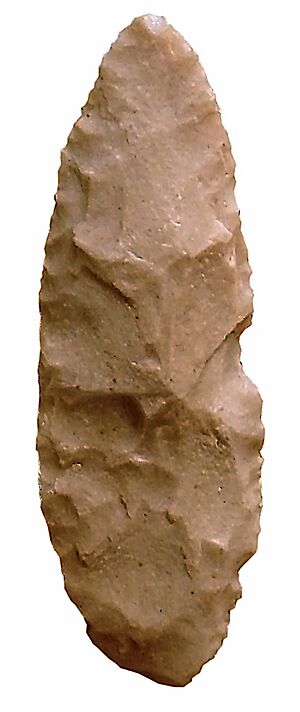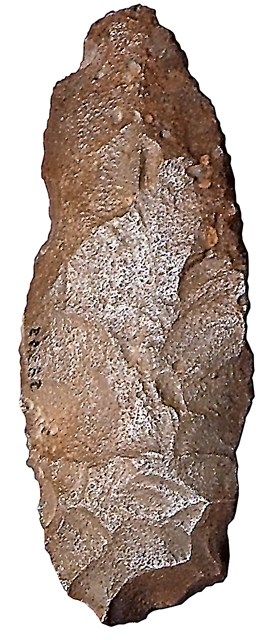Late Stone Age facts for kids
The Later Stone Age (often called LSA) is a time period in African prehistory. It comes after the Middle Stone Age. During the LSA, modern human behaviors became more common in Africa.
Scientists believe the shift from the Middle Stone Age to the Later Stone Age first happened in eastern Africa. This was between 50,000 and 39,000 years ago. It's also thought that people from the Later Stone Age, or their new tools and ways of life, spread out of Africa over the next few thousand years.
It's important not to mix up the terms "Early Stone Age," "Middle Stone Age," and "Later Stone Age" used for Africa with "Lower Paleolithic," "Middle Paleolithic," and "Upper Paleolithic." These different terms were created in the 1920s. This was because the older Paleolithic system didn't fit Africa's ancient past very well.
Contents
What Defined the Later Stone Age?
At first, the Later Stone Age was known for certain stone tools and other signs of human life. These included beads made from ostrich eggshells and tools made from bone. It was also believed that LSA people were directly linked to modern hunter-gatherer groups.
However, this idea has changed over time. Scientists have found ostrich eggshell beads and bone harpoons that are much older than the LSA. This means that some "modern" behaviors appeared earlier than once thought. The LSA was also once seen as the time when modern human behavior fully developed in Africa. But new discoveries show that many modern behaviors were already present in earlier periods.
Changes from the Middle Stone Age
The Later Stone Age began around 50,000 years ago, following the Middle Stone Age. A key difference in the LSA is the much wider variety of stone tools. These tools changed a lot over time and in different places. This is unlike Middle Stone Age tools, which stayed pretty much the same for hundreds of thousands of years.
LSA technology also included the use of bone tools. For a long time, the LSA was linked to the start of behavioral modernity. But discoveries at Middle Stone Age sites, like Blombos Cave and Pinnacle Point, have changed this view. These sites show that modern behaviors existed even earlier.
There are also many more LSA sites found in Africa compared to MSA sites. This might mean that the population grew during the LSA. Or, it could be that younger sites are simply better preserved and easier to find.
Later Stone Age Tools
The types of stone tools used are often how scientists tell the Middle Stone Age and Later Stone Age apart. In the Middle Stone Age, people made large flakes from prepared stone cores, like with the Levallois technique. In the Later Stone Age, people started making smaller blades and bladelets from simpler cores.
Scientists group African stone tool technologies into different "modes." Here are some of them:
- Mode 1: Simple pebble tools, like those from the Oldowan period.
- Mode 2: Tools made by shaping both sides of a large flake or core.
- Mode 3: Flake tools made from carefully prepared cores.
- Mode 4: Long, thin blades made by striking a core with a punch. These blades were then shaped into different tools.
- Mode 5: Very small stone pieces called microliths. These tiny tools were often part of bigger tools, like spears or arrows, which also used wood or bone.
The stone tools from the Later Stone Age usually fall into Modes 4 and 5.
The End of the Stone Age
The Later Stone Age ended when groups of people started using new technologies, like working with metals, instead of just stone tools. This change happened at different times across Africa. Today, archaeologists often use the term "LSA" mainly for hunter-gatherer groups in southern Africa who still used stone tools.
The idea of a sudden "human revolution" during the LSA is not as popular now. This is because more and more evidence shows that modern human behaviors developed gradually, much earlier than 40,000 to 50,000 years ago.
See also
 In Spanish: Edad de Piedra Tardía para niños
In Spanish: Edad de Piedra Tardía para niños



